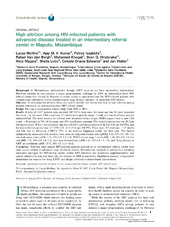High attrition among HIV-infected patients with advanced disease treated in an intermediary referral center in Maputo, Mozambique
Molfino, Lucas; Kumar, Ajay M.V.; Isaakidis, Petros; Van den Bergh, Rafael; Khogali, Mohamed; Hinderaker, Sven Gudmund; Magaia, Alice; Lobo, Sheila; Edwards, Celeste Gracia; Walter, Jan
Peer reviewed, Journal article
Published version

View/
Date
2014-04-08Metadata
Show full item recordCollections
Original version
https://doi.org/10.3402/gha.v7.23758Abstract
Background: In Mozambique, antiretroviral therapy (ART) scale-up has been successfully implemented. However, attrition in care remains a major programmatic challenge. In 2009, an intermediary-level HIV referral center was created in Maputo to ensure access to specialized care for HIV-infected patients with complications (advanced clinical-immunological stage, Kaposi saarcoma, or suspected ART failure). Objective: To determine the attrition from care and to identify risk factors that lead to high attrition among patients referred to an intermediary-level HIV referral center. Design: This was a retrospective cohort study from 2009 to 2011. Results: A total of 1,657 patients were enrolled, 847 (51%) were men, the mean age was 36 years (standard deviation: 11), the mean CD4 count was 27 cells/µl (interquartile range: 11–44), and one-third were severely malnourished. The main reasons for referral were advanced clinical stages (WHO stages 3 and 4, and CD4 count <50 cells/µl) in 70% of the cases, and 19% had Kaposi sarcoma. The overall attrition rate was 28.7 per 100 person-years (PYs) – the mortality rate was 5.0 (95% confidence interval [CI]: 4.2–5.9) per 100 PYs, and the loss-to-follow-up rate was 23.7 (95% CI: 21.9–25.6) per 100 PYs. There were 793 attritions – 137 deaths and 656 lost to follow-up (LTFU); 77% of all attrition happened within the first year. The factors independently associated with attrition were male sex (adjusted hazard ratio [aHR]: 1.15, 95% CI: 1.0–1.3), low body mass index (aHR: 1.51, 95% CI: 1.2–1.8), WHO clinical stage 3 or 4 (aHR: 1.30, 95% CI: 1.0–1.6; and aHR: 1.91, 95% CI: 1.4–2.5), later year of enrollment (aHR 1.61, 95% CI 1.3–1.9), and ‘being already on ART’ at enrollment (aHR 13.71, 95% CI 11.4–16.4). Conclusions: Attrition rates among HIV-infected patients enrolled in an intermediary referral center were high, mainly related to advanced stage of clinical disease. Measures are required to address this, including innovative strategies for HIV-testing uptake, earlier ART initiation and nutritional supplementation, and special attention to men and those who are already on ART at enrolment. Qualitative research is required to understand the reasons for being LTFU and design informed evidence-based interventions.
